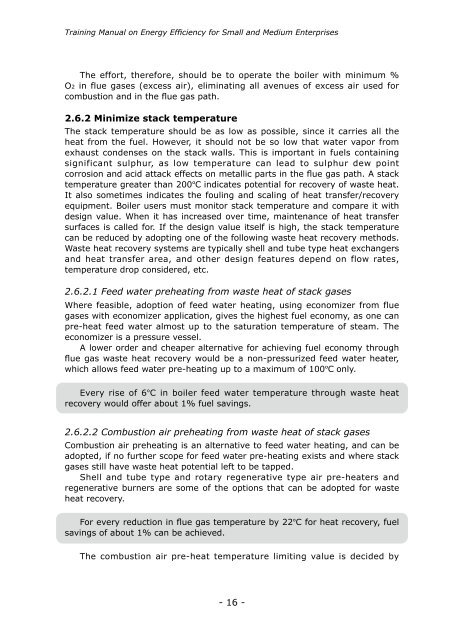Training Manual on Energy Efficiency - APO Asian Productivity ...
Training Manual on Energy Efficiency - APO Asian Productivity ...
Training Manual on Energy Efficiency - APO Asian Productivity ...
Create successful ePaper yourself
Turn your PDF publications into a flip-book with our unique Google optimized e-Paper software.
<str<strong>on</strong>g>Training</str<strong>on</strong>g> <str<strong>on</strong>g>Manual</str<strong>on</strong>g> <strong>on</strong> <strong>Energy</strong> <strong>Efficiency</strong> for Small and Medium Enterprises<br />
The effort, therefore, should be to operate the boiler with minimum %<br />
O2 in flue gases (excess air), eliminating all avenues of excess air used for<br />
combusti<strong>on</strong> and in the flue gas path.<br />
2.6.2 Minimize stack temperature<br />
The stack temperature should be as low as possible, since it carries all the<br />
heat from the fuel. However, it should not be so low that water vapor from<br />
exhaust c<strong>on</strong>denses <strong>on</strong> the stack walls. This is important in fuels c<strong>on</strong>taining<br />
significant sulphur, as low temperature can lead to sulphur dew point<br />
corrosi<strong>on</strong> and acid attack effects <strong>on</strong> metallic parts in the flue gas path. A stack<br />
temperature greater than 200 ºC indicates potential for recovery of waste heat.<br />
It also sometimes indicates the fouling and scaling of heat transfer/recovery<br />
equipment. Boiler users must m<strong>on</strong>itor stack temperature and compare it with<br />
design value. When it has increased over time, maintenance of heat transfer<br />
surfaces is called for. If the design value itself is high, the stack temperature<br />
can be reduced by adopting <strong>on</strong>e of the following waste heat recovery methods.<br />
Waste heat recovery systems are typically shell and tube type heat exchangers<br />
and heat transfer area, and other design features depend <strong>on</strong> flow rates,<br />
temperature drop c<strong>on</strong>sidered, etc.<br />
2.6.2.1 Feed water preheating from waste heat of stack gases<br />
Where feasible, adopti<strong>on</strong> of feed water heating, using ec<strong>on</strong>omizer from flue<br />
gases with ec<strong>on</strong>omizer applicati<strong>on</strong>, gives the highest fuel ec<strong>on</strong>omy, as <strong>on</strong>e can<br />
pre-heat feed water almost up to the saturati<strong>on</strong> temperature of steam. The<br />
ec<strong>on</strong>omizer is a pressure vessel.<br />
A lower order and cheaper alternative for achieving fuel ec<strong>on</strong>omy through<br />
flue gas waste heat recovery would be a n<strong>on</strong>-pressurized feed water heater,<br />
which allows feed water pre-heating up to a maximum of 100 ºC <strong>on</strong>ly.<br />
Every rise of 6 º C in boiler feed water temperature through waste heat<br />
recovery would offer about 1% fuel savings.<br />
2.6.2.2 Combusti<strong>on</strong> air preheating from waste heat of stack gases<br />
Combusti<strong>on</strong> air preheating is an alternative to feed water heating, and can be<br />
adopted, if no further scope for feed water pre-heating exists and where stack<br />
gases still have waste heat potential left to be tapped.<br />
Shell and tube type and rotary regenerative type air pre-heaters and<br />
regenerative burners are some of the opti<strong>on</strong>s that can be adopted for waste<br />
heat recovery.<br />
For every reducti<strong>on</strong> in flue gas temperature by 22 º C for heat recovery, fuel<br />
savings of about 1% can be achieved.<br />
The combusti<strong>on</strong> air pre-heat temperature limiting value is decided by<br />
- 16 -
















